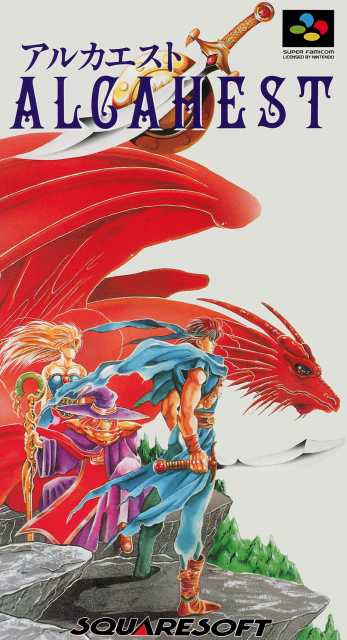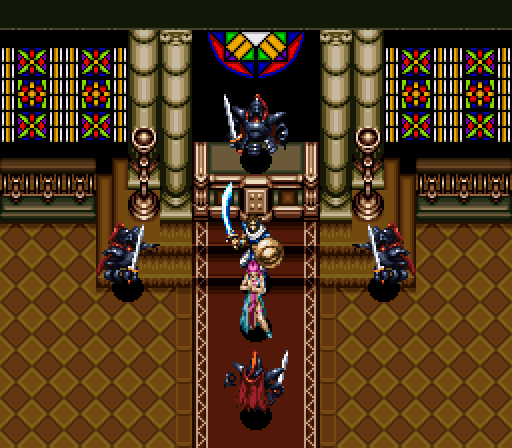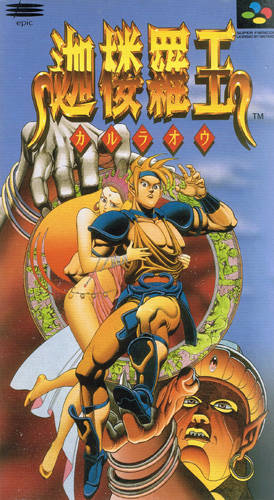The SNES Classic Mk. II: Episode X: Birdman of Alca-Blaz
By Mento 0 Comments
The SNES Classic had a sterling assortment of games from Nintendo's 16-bit star console, but it's hardly all that system has to offer a modern audience. In each installment of this fortnightly feature, I judge two games for their suitability for a Classic successor based on four criteria, with the ultimate goal of assembling another collection of 25 SNES games that not only shine as brightly as those in the first SNES Classic, but have equally stood the test of time. The rules, list of games considered so far, and links to previous episodes can all be found at The SNES Classic Mk II Intro and Contents.
Episode X: Birdman of Alca-Blaz
The Candidate: HAL Laboratory's Alcahest

Kirby, one of the most enduring mascots from the 8-bit era, is capable of creating a massive vacuum that little can escape. Sometimes that feels like it could describe the relationship between Kirby and their developer HAL Laboratory, who are best known for producing an endless procession of Kirby platformers and spin-offs. Of course that wasn't, and isn't, the case: HAL is also responsible for Super Smash Bros., BoxBoy, the Mother/EarthBound series (with Ape), the Adventures of Lolo, a number of Pokémon spin-offs like Snap and Stadium, and Picross 3D. The SNES era saw most of their more unusual output, helping to convert Maxis's SimCity and SimCity 2000 for the console, as well as developing the card-based first-person dungeon crawler Arcana and the Mode 7 tunnel shoot 'em up HyperZone. One or more of those might end up in a future episode of this feature.
Their 1993 game Alcahest (developed in the gap between Kirby's Pinball Land for GB and Kirby's Dream Course for SNES, just to reiterate how much of their time is occupied with the little pink blob) also embodies that pioneer spirit: a top-down action RPG with an arcade shoot 'em up sensibility in the vein of a Pocky & Rocky or Gauntlet, where you'll still navigate dungeons and collect treasure, but do so while picking up power-ups and earning enough score for an extra 1-Up to keep you afloat. The story is the same old pablum you've heard a thousand times - an evil star heralds the return of the eponymous demon lord, and only a swordsman chosen by fate and wielding the four Guardian Blades of legend can hope to stop it - but it's enough of a hook upon which to hang an uncommon merger of RPG and shoot 'em up attributes.
The flow of the game is fairly straightforward too. You are railroaded to the plot-relevant locations, each given a level name and numeral, and tasked with recovering the Guardian Blade housed there while perhaps foiling whatever schemes the antagonistic empire and/or the underworld envoy Babilim have concocted to sow chaos or halt your journey specifically. You can destroy monsters in your path, but they respawn immediately once you leave their part of the screen, so your best bet is to keep moving and keep making progress. Most items are temporary boosts - consumables, mostly, that restock your health, magic, and a partnership-based "SP" stat - but there's just enough permanent ones hidden around (maximum health and magic) that you owe it to your future struggles to not leave any stone unturned. Each level also has four "stage items": Zelda-like progression items needed to move ahead, but lost once the stage is complete. These might be direct progress items like keys for doors or hammers to destroy rock barricades, but could also be items that make life easier such as lavaproof boots or a pair of crystal glasses that let you see previously invisible enemies. You invariably need all four to reach the end of a level, taking a circuitous route around to pick them all up, whereupon you'll then fight a boss or two.

Alcahest has a few neat ideas to go with its simple premise. The first is how its lives system works: extra lives are gained from reaching score milestones, with tougher monsters earning you more points. However, the milestone score you need to reach changes depending on the number of lives you currently have; if you're down to just one or two lives left, the next milestone to hit is relatively small and attainable, but it's almost insurmountable if you've been walking around with a healthy buffer. With this, the player rarely has enough lives that they can waltz through the game, but shouldn't struggle to recoup their losses after a particularly vicious boss. The player can also switch between the elemental Guardian Blades they've found so far, each with a different associated spell and charge-up attack. The charge-up attack is the best means of causing damage to bosses without relying on a finite supply of mana, but it does mean having to wait a few seconds and then carefully aiming the attack for maximum benefit. The spells, meanwhile, can range from summoning helpers to temporary invincibility. Some bosses have Mega Man-style weaknesses to exploit too, expanding the necessity of experimenting with what you have. Last, there are the partner characters: for most of the game, they join and subsequently leave your side as the story demands (usually to let someone else take over), but all five will become available towards the end of the game and can be switched around at any time. They operate similarly to the options in shoot 'em ups, adding their own attacks to yours (with various output modes, from homing shots to three-way spreads), and can be used for co-operation abilities that, again, give you some amount of variation to play around with if you're struggling with your current strategy. Princess Elikshil, for instance, will heal you as her co-op ability, making her invaluable for protracted boss battles but less apposite when mounting an all-out offensive to take the boss down quickly.
There's a lot more to say about Alcahest, but in order to keep this appraisal within a sensible character limit it might be prudent to get some P.O.G.S. action in:
- Preservation: Alcahest can feel a little dated, but only because I could see how a modern Indie developer - who might've played this game in their youth had anyone thought to localize it for an international audience - could iterate on the formula. We've seen a number of recent ARPGs that drift a little closer into all-out arcade-style action games (a recent favorite of mine was CrackShell's Hammerwatch, but you also see it in roguelites that go for a more real-time focus like The Binding of Isaac). Its pedigree, level of design ingenuity, and firm difficulty, means it's aged better than most. 4.
- Originality: There were only a handful of games that picked up where Atari's Gauntlet left off in the 1980s, merging traditional RPG and shoot 'em up gameplay. Alcahest's definitely novel in that respect, but its true originality is in adopting various different modes to switch between on the fly for a level of customization rarely seen in the 16-bit era. It's not quite Super Metroid or A Link to the Past in terms of its adaptability, but it feels like there are a number of different skill loadouts to explore. It's a bit of a shame that it takes a while for the game to give you full access to all the Guardian Blades and companions. 4.
- Gameplay: For the most part, Alcahest is a breezy - if not easy - action game with the occasional traversal puzzle to overcome and detours to take. Its boss fights are both the highlight and its lowest point, depending on which boss you happen to be fighting; most are fun to work out and strategize around, but there are a few that feel a bit "battle of attrition"-like in how little space you have to work with and how frequently your attacks leave you open for collision damage. Add to that the occasional annoying flying enemy that proves hard to hit with the game's adherence to eight-directional movement or how it can be slightly confounding the way floor hazards track the small hitbox where your character's feet are rather than the sprite's center, and it's far from perfect if still overall quite good. 3.
- Style: While it doesn't look much like a HAL game (its large, realistically-proportioned character sprites actually remind me more of a Produce RPG like 7th Saga or Brain Lord), it unmistakably sounds like one thanks to the involvement of longtime HAL composer Jun Ishikawa. In fact, there are certain tunes in this game (like this boss track) that resemble something out of Kirby Super Star. At the same time, there are plenty of tracks that befit the game's medieval fantasy sensibility, as well as a few for when the game inevitably heads into the ruins of the customary long-dead super high-tech civilization. 4.
Total: 15.
Other Images:
The Nominee: Ukiyotei's Skyblazer

Like Alcahest, Skyblazer is a fantasy-themed action game with just a few flirtations with RPG mechanics and non-linear progression. Unlike Alcahest, Skyblazer had the fortune of being officially localized and released in English-speaking territories, and yet... well, let's suggest that there's a good chance that both of these games sound equally familiar to you. It's a little unfair really: Alcahest is a decent game from a major Nintendo-affiliated developer with very little text to translate that nonetheless stayed in Japan, while Skyblazer deserved way more success and acclaim than it ever saw. Easily the rival of Capcom's Demon's Crest or Konami's Super Castlevania IV, Skyblazer has the player (as Sky) tackle a series of platforming-intensive levels and the occasional aerial shooter stage in their pursuit of Arianna, a sorceress that was kidnapped by the seemingly invincible henchman Ashura (in the Japanese version of the game, every character was named for a Hindu/Buddhist deity) and taken to be sacrificed to his dark god Raglan.
Despite being trounced in one of those unwinnable story battles during the prologue, Sky's far too eager to catch up to Ashura. An old man takes him aside and shows him the error of his ways, sending him on a roundabout quest through all the major dungeons of the world in order to build his strength and obtain all the abilities he might need, including the blessing of the mythical phoenix. While the game has a world map, there's no variation in which levels to tackle in which order: rather, the map exists so you can retrace your steps to the old man and the password generator, which the game uses in lieu of saves. The game's big draw are the upgrades Sky can attain, which include expensive "boss killer" nukes as well as a healing spell and the traversal-enabling Comet Flash, really make the later chapters of the game stand out with the level of mastery over the ground and skies that you eventually attain. I'd liken it to the way you end up shine-sparking and screw-jumping your way through Super Metroid's Planet Zebes towards the end of the playthrough as you head to the final area or backtrack for a few missing items. It's a slow burn, but that's an intentional part of the design: you factor your new acquisitions into your repertoire as you find them, experimenting with what kind of abilities work best where, and using that knowledge to take down Skyblazer's reasonably challenging rogue's gallery of bosses. The game also has a lot of fun Mode 7 stuff, if that's what appeals to you most about the SNES library: the flying sequences that occasionally break up batches of regular platforming levels are breezy bonus stage cooldowns, and there's at least one boss that spins the arena around itself, forcing you to navigate through gaps in the crushing walls.

Skyblazer's long been one of my secret favorites for the system, ever since a stupidly long guide printed in my preferred SNES magazine convinced me to try it, and I'm happy to sing its praises whenever the opportunity arises. That said, there's only so far any subjective affection can go under the strict, methodical judgement of the P.O.G.S. system:
- Preservation: It passes the usual qualifiers - great pixel art, fluid and responsive controls, and a few novel ideas that haven't been done to death - but some respects have dated it a little. You have a lives system, for one, though you always start at the last exit you passed through and only get tossed back to the password screen if you should lose them all. There are 1-Ups and gems (with the usual Mario currency-to-lives exchange rate) aplenty though, so it's usually only an issue if you crash and burn on the same boss one too many times. Let's say it uses lives in a way that doesn't feel too outmoded. 4.
- Originality: Skyblazer's traversal upgrades and wall-climbing/jumping mechanics have been seen before, though rarely together, but the game does separate from the crowd a little by entrenching itself in Hindu/Buddhist mythology and architecture. Beyond the character names, the various locations and the soundtrack all have a South Asian feel that most games, not even Japanese ones, attempt too often. The Mode 7 shoot 'em up stages are a nice touch too. 4.
- Gameplay: What I appreciate most about Skyblazer is that it's tough without being overly difficult in the way older games can be. The worst that can happen to you is that you get kicked out the current stage after losing all your lives, giving you a chance to restock on 1-Ups and perhaps find a secret area you missed before. The wall-climbing/jumping right off the bat is a nice thing to have, and the way you can incorporate the charging Comet Flash to cross gaps or get around enemies helps considerably. Bosses can be a little bullet-spongey if you're not using the strongest spells in your arsenal, and sometimes you aren't feeling the flying stages, but it's a well-crafted and varied game from a level design perspective. 4.
- Style: Skyblazer looks great. It showed up in the middle of the SNES's lifespan, around the point where most developers were comfortable working with the 16-bit color palette and graphical limitations of the SNES, and Skyblazer has some nice parallax scrolling and Mode 7 in its favor. The game has some smaller touches too, like the way Sky's baggy clothes billow when he idles or falls. 4.
Total: 16.
Other Images:














